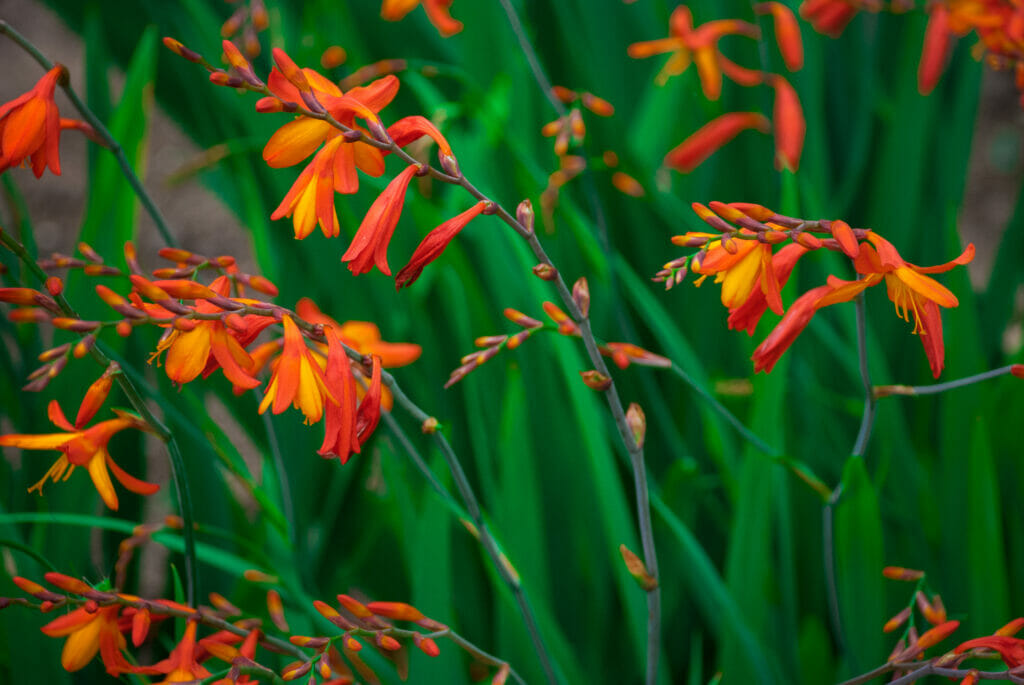Montbretia, often misspelt as ‘monbretia’, is a hybridized member of the Crocosmia genus. Originating from South Africa there are 8 species of crocosmia. They are members of the iris family and are characterized by their long, sword-shaped leaves and bright orange, red, or yellow flowers.
First hybridized in 1881 by Victor Lemoine, Montbretia, is a cross between Crocosmia pottsii and Crocosmia aurea. Originally named Montbretia crocosmaieflora it is now known as either Crocosmia x crocosmiiflora or more simply by its common name Montbretia. A great success the plant was, and still is, planted in many gardens for its beautiful large red flowers. Sadly, the vigour and hardiness of this hybrid have meant that when it inevitably jumped the garden wall it quickly established its self as an invasive species.
What’s in a name, is there a difference between Crocosmia and Montbretia?
There is a lot of confusion surrounding what exactly Monbretia is! Many people use the term Crocosmia to describe Montbretia. However, ‘Crocosmia’ is actually the genus in which the hybrid plant montbretia is included in. There are in fact 8 wild species of crocosmia and upwards of 400 known cultivars! So strictly speaking, no, montbretia and crocosmia are not the same. Montbretia is the common name for a hybrid of two of the original species of crocosmia.
How do you identify Montbretia?
Montbretia is relatively easy to identify plant. It has long, sword-shaped leaves that are arranged in a fan shape. The leaves are green and can be up to 3 feet long. Montbretia flowers are very distinct. They produce tall erect stems that are topped with clusters of bright orange, red, or yellow flowers.
Under the ground Montbretia bulbs (actually known as corms) form chains of little globes. these can easily separate and form new plants. These corms are similar to bulbs but are actually an adapted stem. The plant produces a new corm each year. Each new corm can produce a new plant.
Is Montbretia invasive?
Montbretia IS considered to be an invasive plant and as such is now included in the schedule 9 list of invasive species. Due to its ability to spread quickly and outcompete native plants it is illegal to allow or cause montbretia to grow in the wild. It is not illegal to grow montbretia in your garden but it can quickly take over and become a problem.
It is important to note that not all crocosmia’s are as invasive as Montbretia. Other crocosmia hybrids (such as crocosmia ‘lucifer’) are well suited to the garden and will not take over.

Crocosmia (montbretia) orange, small flowers iStock/surotbar
How to get rid of Montbretia
The three most effective methods of removing Montbretia are:
- Hand pulling
- Herbicide application
- Mechanical excavation (with either burying of the debris or removal to a licenced waste facility)
Hand pulling is only really suitable for small clumps of Montbretia, but can only be done effectively when the soil is damp. It is vital to extract all the corms when pulling by hand. If left in the soil corns will quickly regenerate into new vigorous plants.
Herbicide application is effective but often requires multiple applications before the corms are fully dead and unable to regenerate. It is better for dealing with larger stands that would be difficult to manage by hand pulling. Herbicides that are available to the public are unlikely to be very effective. If dealing with a large stand of Montbretia it would be advisable to use invasive weed professionals who will have access to stronger more effective herbicides.
Mechanical excavation involves digging (usually with the use of machinery) to a minimum depth of 75cm. The waste from excavation can then either be buried on site (at a depth of 2 metres) or removed to a licensed waste facility. This is likely the most expensive and disruptive option.
In reality it is likely that the most effective method of eradicating Montbretia will be a combination of these techniques. The site conditions and size of the stand will dictate the method. This is why if you have a problem with montbretia on your property it is important to seek advice from qualified professionals. They will be able to create a realistic management plan to deal with the problem and document the process.
Why it should be dealt with
Montbretia is indeed an invasive species. Despite its pretty looks it can spread rapidly and over grow more delicate plants both in the garden and the wild. When dealing with Montbretia it is important not to cause it to spread outside of your property as this would not only be a criminal offence but is also damaging to the environment.
Montbretia can be dealt with by hand but if it is a big stand then this method will be labour intensive and likely take a long time. A combination of excavation and herbicide over a period of time is often the best option. If you have a large stand to deal with it may be better to call in professionals that have access to stronger herbicides and can advise on the best management plan for complete eradication.
At PBA Solutions, we deal with a wide range of invasive plant species. We are always happy to offer identification assistance and offer advice on the best solutions. If you are concerned about the presence of Montrebretia or another invasive plant species, call 0203 174 2187 or 01202 816134 to talk to one of our consultants today.
Lead image iStock/Antonio DuarteMon

